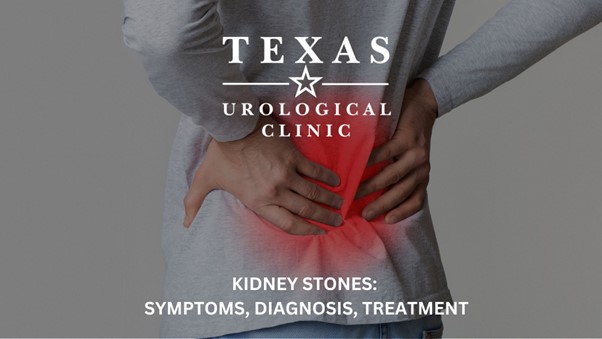
Kidney Stones: Symptoms, Diagnosis & Treatment
Kidney stones represent a prevalent and often excruciatingly painful health concern that affects men and women equally. These tiny, rigid mineral accumulations develop within the kidneys and induce severe discomfort as they traverse through the intricate passages of the urinary tract. Understanding the symptoms, diagnostics and treatments associated with kidney stones can help prevent and manage kidney stones.
Symptoms:
Recognizing the symptoms of kidney stones is the first step towards prompt diagnosis and treatment. Common signs include intense pain in the back, side, abdomen, or groin, accompanied by nausea, vomiting, and blood in the urine. However, some individuals may experience no symptoms until the stone starts moving within the urinary tract.
Diagnostics:
Diagnosing kidney stones typically involves a combination of medical history, physical examination, and diagnostic tests. Imaging studies such as X-rays, CT scans, or ultrasounds help healthcare professionals visualize the stones and determine their size and location. Urine tests may also be conducted to analyze the composition of the stones and identify underlying causes.
Treatment:
The appropriate treatment for kidney stones depends on factors such as the size, type, and location of the stone, as well as the severity of symptoms. In many cases, small stones can pass naturally with adequate hydration and pain management. However, larger stones or those causing complications may require medical intervention. Common treatment options include:
- Pain Management: Over-the-counter or prescription medications can help alleviate pain and discomfort associated with kidney stones.
- Fluid Intake: Increasing fluid intake helps flush out the stones and prevents dehydration, a key risk factor for stone formation.
- Medications: Certain medications may be prescribed to help dissolve or prevent the formation of specific types of kidney stones.
- Extracorporeal Shock Wave Lithotripsy (ESWL): This non-invasive procedure uses shock waves to break up kidney stones into smaller fragments that can be passed more easily.
- Ureteroscopy: In this minimally invasive procedure, a thin scope is inserted through the urethra and bladder to remove or break up stones located in the ureter or kidney.
- Percutaneous Nephrolithotomy (PCNL): For large or complex stones, a surgical procedure called PCNL may be necessary to remove the stones through a small incision in the back.
Prevention:
Preventing the recurrence of kidney stones involves lifestyle modifications and dietary changes aimed at reducing the risk factors associated with stone formation. This includes maintaining adequate hydration, adopting a balanced diet low in sodium and oxalate-rich foods, and avoiding certain foods and beverages known to contribute to stone formation.
Some of these foods include:
- Sodas: Beverages high in sugar and phosphates can increase the risk of kidney stones.
- Red meat: High consumption of animal protein, particularly from red meat, can raise the risk of kidney stone formation.
- Processed foods: Foods high in sodium and preservatives can contribute to kidney stone formation.
- Spinach: Although nutritious, spinach contains oxalates, which can increase the likelihood of calcium oxalate kidney stones.
- Caffeine: Excessive consumption of caffeinated beverages like coffee and tea can lead to dehydration, which is a risk factor for kidney stones.
- Salt: High sodium intake can lead to increased calcium excretion in the urine, promoting the formation of kidney stones.
- Alcohol: Excessive alcohol consumption can dehydrate the body, leading to concentrated urine and a higher risk of kidney stones.
- Chocolate: Chocolate contains oxalates, which can contribute to the formation of calcium oxalate kidney stones.
- Nuts: Certain nuts, like almonds, cashews, and peanuts, are high in oxalates and may increase the risk of kidney stones.
- Soft drinks: Beverages high in fructose, such as certain soft drinks and fruit juices, can increase the risk of kidney stone formation.
Those diagnosed with kidney stones should talk about diet with their doctor and create a food plan that can lessen the risk of recurring kidney stones.
Navigating kidney stones involves understanding the symptoms, seeking timely diagnosis, and exploring appropriate treatment options. By staying informed and proactive about kidney stone management, individuals can alleviate discomfort, reduce the risk of complications, and enhance their overall well-being.
If you or a loved one are experiencing symptoms of kidney stones, we encourage you to reach out to Texas Urologic Clinic. Dr. Shawn Todd provides compassionate care and effective solutions tailored to your needs.
Call Texas Urologic Clinic at 936-899-7070 to make an appointment.
Works Cited:
“How to Prevent Kidney Stones.” Harvard Health, 13 June 2023, www.health.harvard.edu/blog/5-steps-for-preventing-kidney-stones-201310046721 Accessed 23 Feb. 2024. Professional, Cleveland Clinic medical. “Kidney Stones: Symptoms, Causes, Diagnosis, Treatment & Prevention.” Cleveland Clinic, my.clevelandclinic.org/health/diseases/15604-kidney-stones. Accessed 23 Feb. 2024.

